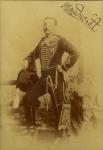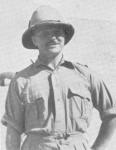-
Posts
552 -
Joined
-
Last visited
-
Days Won
2
Content Type
Profiles
Forums
Blogs
Gallery
Events
Store
Everything posted by Gunner 1
-

OBE citations?
Gunner 1 replied to ColinRF's topic in Great Britain: Orders, Gallantry, Campaign Medals
Colin: You might also try the local newspapers around the date that the OBE award was made. Gunner 1 -

OBE citations?
Gunner 1 replied to ColinRF's topic in Great Britain: Orders, Gallantry, Campaign Medals
Colin: I do not know if citations are issued but there were certainly recommendations written when the person was recommended for the award. The National Archives have made available the existing recommendations for World War II awards but not the later ones. You might check with the Chancery of the Order to see if they can supply any information or with the headquarters of Staffordshire Fire Brigade. Gunner 1 -

OBE citations?
Gunner 1 replied to ColinRF's topic in Great Britain: Orders, Gallantry, Campaign Medals
A H Finney received the OBE in the London Gazette of 1 January 1955 for service as Chief Officer, Staffordshire Fire Brigade (no citation published). From 1936 to 22 July 1941 he was Inspector and Principal Fire Officer, Wolverhampton and on 23 July 1941 he was appointed Fire Force Commander, Stoke Area. Regards, Gunner 1 -

Battle of Diamond Hill
Gunner 1 replied to st helena's topic in Great Britain: Research, Documentation & History
D: Further to your question concerning the Battle of Diamond Hill which was fought on 11-12 June 1900. The History of "J" Battery, Royal Horse Artillery indicates that on 10 June 1900 the battery made preparations for the next two days' engagement, later known as 'Diamond Hill'. "Colonel Henry had 700 men and the battery to hold three and half miles of front from Marks' Farm to the north and the range of hills starting 6000 yards from the main Boer position and running east and west. Shots were exchanged with the Boer outposts from the eastern extremity of the hill, near Bavaans Poort and patrols to the north of it were engaged. Unless a counter attack was made by the enemy this part of the could not be seriously engaged. At dusk, the battery returned to its former camp, and on the 12th repeated the previous day's experiences. Two Boer guns opposing the Cavalry Division were seen in action, but were entirely out of range, being over 6000 yards from the nearest point the battery could approach. The bivouac that night was south-west of Bavaans Port." As your great-uncle only received the Orange Free State and Cape Colony clasps he did not take part in any of the operations in the first half of 1900 conducted by J Battery. He either was not with the battery when it took part in those operations (including Diamond Hill), or he was employed elsewhere at the time. Those men from 'J' Battery RHA who took part in the 'J' Battery, RHA operations in the first half of 1900 received the clasps for Johannesburg, Diamond Hill and Belfast. Regards, Gunner 1 -

Battle of Diamond Hill
Gunner 1 replied to st helena's topic in Great Britain: Research, Documentation & History
D: You need to obtain a copy of History of "J" Battery, Royal Horse Artillery by Major Guilbert E Wyndham Malet, RHA. It has recently been reprinted by Naval & Military Press and can be purchased from them from their online shop. Over half of the book covers J Battery's service during the South African War. Regards, Gunner 1 -

New British finds
Gunner 1 replied to CRBeery's topic in Great Britain: Orders, Gallantry, Campaign Medals
The ribbon bar without visible attachment system is not unusual for both ORs and officers. I have similar ribbon bars from both wars. Your ribbon bar probably belonged to a long serving regular NCO as he has the Long Service and Good Conduct Medal ribbon. The presence of the 1939-45 Star without any other campaign stars would indicate that he probably served in France or Norway in 1940 and then remained in the UK for the remainder of the war. Gunner 1 -

American (US) Victory Medals
Gunner 1 replied to Kev in Deva's topic in Inter-Allied Victory Medals of the Great War
Hugh wrote: Charles William Jenkins is not listed in the nominal roll in my copy of the History of 311th Machine Gun Battalion, 79th Division AEF. Gunner 1 -
An interesting array of medals for an officer who was a TF officer during the Great War (note the TFWM). It is also interesting that he has a CB and a Civil OBE/CBE. The right hand medal in the third row completely perplexes me as it appears to be a Royal Navy LS & GC Medal which does not seem to fit the rest of the ribbons. The GSM with the MiD emblem must be a pre-WWII campaign as it is worn prior to the WWII medals. It is also rather interesting that he received the CB but did not have an MiD for WWII. There can't be too many officers who have the CB, Civil CBE/OBE, DSO, MC/Bar combination. Gunner 1
-
There is no 1939-1945 Star in the MBE group because he did not have six months service in an operational command, but received the France and Germany Star because it only required participation in an operation on land in France, Germany, etc. (it had no prior time qualification). A group with a France and Germany Star but with no 1939-1945 Star is not an uncommon occurrence. Gunner 1
-

The Canadian Memorial Cross
Gunner 1 replied to Brian Wolfe's topic in Great Britain: Orders, Gallantry, Campaign Medals
Brian Wolfe wrote: The above statement is not entirely accurate, as many Memorial Crosses awarded early in World War II were actually Great War crosses with the GV cypher. The Memorial Cross below was issued to Major Arthur Boyston Slee who won the MC as a Major in the RFA during the Great War. After the war he emigrated to Canada and during the early part of World War II he was a Major in the Royal Canadian Artillery serving with No. III N. P. A. M. Training Center at Saanich, British Columbia. He died of a heart attack on 31 October 1940 and was buried at Duncan, B.C. Memorial Crosses were issued on 26 June 1941 to his wife and mother, and were of the Great War type with the George V cypher. Gunner 1 -

J Battery Royal Horse Artillery
Gunner 1 replied to st helena's topic in Great Britain: Research, Documentation & History
The photo below is Major Louis Hay Ducrot, RHA who commanded J Battery, RHA from 14 March 1901 to 23 July 1902. -

BRITISH C.B.E.
Gunner 1 replied to Mervyn Mitton's topic in Great Britain: Orders, Gallantry, Campaign Medals
Odin Mk 3 wrote: I wonder if the 'breast ribbon' is the 'shoulder bow' that is worn by female recipients of the CBE? Gunner 1 -

India General Service Medals
Gunner 1 replied to a topic in Great Britain: Orders, Gallantry, Campaign Medals
-

India General Service Medals
Gunner 1 replied to a topic in Great Britain: Orders, Gallantry, Campaign Medals
India General Service Medal (1908) with clasp 'BURMA 1930-32' to a Lieutenant, 7th (Bengal) Mountain Battery, RA. Only five of this clasp were awarded to the Royal Artillery. The recipient was a Brigadier immediately after World War II. -

General Service Medal 1918 - 1962
Gunner 1 replied to a topic in Great Britain: Orders, Gallantry, Campaign Medals
A GSM with clasp 'NW Persia' to a Captain (later Brigadier) RA. Only 11 of these single clasps were awarded to Royal Artillery officers. -

General Service Medal 1918 - 1962
Gunner 1 replied to a topic in Great Britain: Orders, Gallantry, Campaign Medals
A GSM with 'South Persia' clasp from a group to a Captain, RGA. Only 15 of these clasps were issued to Royal Artillery officers. -

1st. WW BOXED M.C.
Gunner 1 replied to Mervyn Mitton's topic in Great Britain: Orders, Gallantry, Campaign Medals
Mervyn: As far as I know the Military Cross has never been hallmarked on the reverse. The reverse of the MC was plain until 1938 when they began to engrave the date of award at the bottom of the lower arm of the cross. Regards, Gunner 1 -

1st. WW BOXED M.C.
Gunner 1 replied to Mervyn Mitton's topic in Great Britain: Orders, Gallantry, Campaign Medals
Ribbon looks fine to me. May be the colors on your monitor. Gunner 1 -

1st. WW BOXED M.C.
Gunner 1 replied to Mervyn Mitton's topic in Great Britain: Orders, Gallantry, Campaign Medals
The only 'James Barnes' who received the MC during the Great War was Lieut. James Barnes, Intelligence Corps, London Gazette 4 June 1917. There is no MC recipient with the name 'James Barne.' Gunner 1 -

The Royal Artillery
Gunner 1 replied to leigh kitchen's topic in Great Britain: Militaria: Badges, Uniforms & Equipment
I would suggest that only 'RA' is shown on the BWM and VM to save money as it would have taken considerable research to determine the corps of many men (i.e. RHA, RFA or RGA) as many served in more than one corps during the Great War. Many Boer War medals were named to the battery the man served in while others were only named to RHA, RFA or RGA. Gunner 1 -
The October 1957 issue of the Canadian Army Journal on pages 112-124 contains an article entitled "Adventure in North Russia" which has the following concerning the Slavo-British Battalion: "Captain Royce Dyer DCM, MM, one of the Canadian officers of the Mission who had served in France as an NCO in the 8th Battalion ("Little Black Devils") from Winnipeg, was given a Slavo-British Battalion to command. His soldiers were drawn from the least unsavory elements found in the gaols after the counter-revolution in Archangel. Dyer's adjutant was an Australian, Bourke, and his interpreter an escaped PW from the Austrian Army. Dyer was later to die from pneumonia contracted in 60-below weather, and his successor as CO, Bourke, was murdered along with eight British subalterans and NCOs when the battalion mutinied soon after taking over a sector of the Dwina front." Regards, Gunner 1
-
-
-










